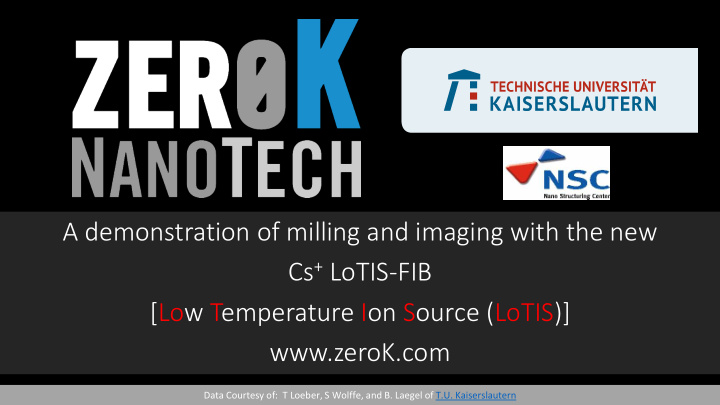



A demonstration of milling and imaging with the new Cs + LoTIS-FIB [Low Temperature Ion Source (LoTIS)] www.zeroK.com Data Courtesy of: T Loeber, S Wolffe, and B. Laegel of T.U. Kaiserslautern
Introduction These slides compare the milling and imaging performance of zeroK’s new ion source technology (Cs + LoTIS) to the Ga + LMIS used in so many instruments today Images labeled “SEM” and “Ga + Ion” were acquired using a Thermo Fischer (FEI) Helios Dual Beam run by researchers from TU Kaiserslautern “Cs+ LoTIS” images were acquired with zeroK’s LoTIS -FIB system • FIB systems incorporating this new ion source technology are now available • All LoTIS images and milling were performed with a 10 kV beam energy with a few pA current (except as noted)
Depth of Focus Comparison (Results on slides that follow) FEI: SEM image “Wood Pile” Nanostructures • Heights: 40 µm, 80 µm, 120 µm • In the following slides we acquire an image containing both the top and bottom of such the 120 µm (tallest) structure • We can compare the depth of focus of various beams by comparing the ‘blurriness’ of the top of the structure A better depth of focus aids in the milling and imaging of ‘deep’ or ’tall’ structures.
Depth of Focus Comparison → LoTIS depth of focus substantially better than SEM SEM Cs+ LoTIS 4 µm “Wood Pile” Height 120 µm
Depth of Focus Comparison → LoTIS depth of focus substantially better than Ga Ga + LMIS Cs + LoTIS 5 µm “Wood Pile” Height 120 µm
Cs + LoTIS Interaction Volume (Theoretical/SRIM Calculations) Comparison of where ion finally resides for three typical beams into Si Cs + has significantly reduced straggle and implant depth than other beams From this: LoTIS is expected to improve milling performance, and leave less residual material from the primary beam in milled structures Ne + 10 kV Ga + 30 kV Cs + 10 kV
Cs + LoTIS Theoretical Milling Rates → Similar to Ga, better then He/Ne Milling rate of 10 kV Cs + LoTIS about 15% lower than 30 kV Ga + for Si Cs + LoTIS milling rates 90% higher than Ne + LoTIS Gas chemistry-driven processes: • XeF 2 tests shows similar etch enhancement to Ga + • Gas-assisted deposition of insulators (TMCTS) and conductors (Tungsten) shown to work Ne 10 kV Ga 30 kV Cs 10 kV 1.00-1.38 at/ion 2.20-2.40 at/ion 1.90-2.15 at/ion
Metal Grain Contrast → LoTIS offers enhanced resolution and differing contrast Ga + LMIS Cs+ LoTIS 1 µm
Metal Material Contrast: Sample: P1369 GaAs wafer with GaAs and AlGaAs layers Ga + LMIS Cs+ LoTIS 4 µm Setup: Sample was milled to depth using LoTIS (1 nA), then imaged with the beam indicated. Cross section’s are unpolished. This is a straight vertical sputter
Material Contrast: → Cs + LoTIS provides superior contrast Ga + LMIS Image Cs+ LoTIS Image 2 µm Sample was milled to depth using LoTIS, then imaged with the beam indicated. Cross section’s are unpolished. This is a straight vertical sputter
Material Contrast: GaAs and AlGaAs → SEM Proves little/no contract between these materials SEM Cs+ LoTIS 2 µm
Milling Homogeneity: 150 nm Au on Si → Cs + LoTIS proves even touchdown Milled with Ga + LMIS Milled with Cs + LoTIS - milled rectangle ‘almost through’ the Au layer - milling time Ga and Cs almost the same
Milling Homogeneity: 150 nm Au on Si (Cross-Section of previous slide) Milled with Cs + LoTIS Milled with Ga + Cs + LoTIS proves near-complete sputtering of Au layer with much less sputtering of Si layer beneath than Ga +
Milling Accuracy: 110 nm Au on Si → LoTIS provides clean mill boxes with sharp corners Milled with Ga + LMIS Milled with Cs + LoTIS - squares with 1, 0.6, 0.4, 0.2, 0.1 and 0.05 µm length - milled through the Au layer - milling time Ga and Cs almost the same
Milling Accuracy: 110 nm Au on Si → LoTIS Can mill very narrow trenches Milled with Ga + LMIS Milled with Cs + LoTIS - lines with “single pixel”, 8 nm, 20 nm, 40 nm, 80 nm, and 100 nm width - milling dose kept constant for all lines (except SPL) - milling time Ga and Cs almost the same
Milling Accuracy: 110 nm Au on Si (cross section of trench from previous slide) Milled with Ga + LMIS Milled with Cs + LoTIS LoTIS Milled trenches: - Steeper walls - Less ‘rounding’ at top - Less material mixing and cleaner interface at bottom
Recommend
More recommend